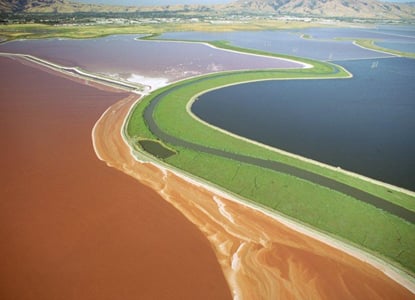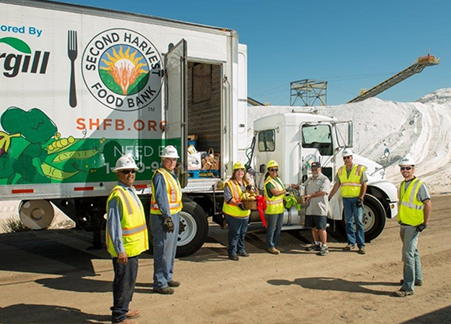Cargill's salt works in the San Francisco Bay Area is an ideal area for salt making, thanks to clay soils and a Mediterranean climate – just enough rain in fall, winter and spring, followed by dry summers with steady breezes and summer sunshine.
Using natural power from the sun and wind, Cargill’s 12,000+ acres of salt ponds are capable of crystallizing 500,000 tons of sea salt each year.
Donating more than $150 million in land value, Cargill has conveyed more than 40,000 acres of salt ponds to public wildlife agencies, a legacy that helped launch San Francisco Bay's environmental renaissance and Cargill's continued commitment to the Newark, Fremont and Redwood City communities.
 The pumpkin color of this salt pond comes from the salt-saturated brines and contrasts with the chartreuse of a nearby marsh and the blue unsaturated brines in a nearby concentrator pond.
San Francisco Bay Salt
Newark, California. United States
The pumpkin color of this salt pond comes from the salt-saturated brines and contrasts with the chartreuse of a nearby marsh and the blue unsaturated brines in a nearby concentrator pond.
San Francisco Bay Salt
Newark, California. United States
How Salt is Made
Flying over the bay or driving over some of the area’s bridges, you will notice salt evaporation ponds with distinctive colors: beautiful green and red hues, colored by the micro-organisms that thrive at varying salinity levels. As the sun and wind evaporate water from the brines, they get saltier. The saltiest brines are moved to crystallizers within our industrial plant sites.
Much of Cargill’s South San Francisco Bay footprint is devoted to salt evaporation ponds. Micro-organisms lend the ponds their bright colors ranging from blue-green to deep magenta, depending on the salinity and season.
The intake pond begins the series of evaporation ponds (sometimes called evaporators, concentrators or concentration ponds). Bay water is pumped into these ponds and slowly moved through a series of evaporation ponds to gradually increase salinity. Once a high salinity is achieved, fresh water evaporates. The process takes about three years.
Evaporation ponds also provide habitat for more than 70 species of birds. Because the ponds are shallow – an average of 1.5 feet deep – it's easy for shorebirds and waterfowl to find a meal in the ponds.
After the salt brines reach full saturation, they are pumped into crystallizer beds at Cargill’s harvest sites. Crystallizers are precipitation beds, usually rectangular in shape and surrounded by wooden bulwarks. They are engineered beds that have been rolled, graded, sloped and compacted for the smooth precipitation and mechanical harvesting of salt. This is where Cargill begins the harvests of the salts – up to 500,000 tons each year.
Preserving the San Francisco Bay
Cargill is committed to preserving the San Francisco Bay for future generations. We’ve worked collaboratively with local stakeholders for years to protect and improve the Bay Area.
In the past 40 years, Cargill has conveyed more than 40,000 acres of salt ponds to public wildlife agencies – at an estimated value of $150 million. These donations include:
- Don Edwards San Francisco Bay National Wildlife Refuge. A century of sustainable land use led to the creation of the Don Edwards San Francisco Bay National Wildlife Refuge on 15,000 acres of salt ponds in 1979. This private-public partnership has expanded over the years and continues to protect wildlife habitat for four endangered species and more than 1 million shorebirds and waterfowl.
- Napa-Sonoma Marshes Wildlife Area. In 1994, Cargill’s donation and sale of 10,000 acres of salt ponds in Napa created the Napa-Sonoma Marshes Wildlife Area, operated by the California Department of Fish and Wildlife. In 2003, 1,400 acres were added to this state wildlife preserve and opened to tidal action in 2010.
- South Bay Salt Pond Restoration Project. State and federal wildlife agencies acquired 15,100 acres of South Bay salt pond properties in 2003, aided by donations from four private foundations and Cargill’s donation of $100 million in land value. This acquisition launched the South Bay Salt Pond Restoration Project, the largest wetland restoration project on the West Coast.
- Bay Trail connection. Over the years, Cargill has provided more than 78 miles of trail ringing the San Francisco Bay.
- Local governments and non-profits have acquired about 3,000 acres through Cargill land grants and sales to improve open space, public access and environmental education throughout the San Francisco Bay Area.
More Information
 Cargill is a well-known benefactor of nonprofit, environmental, educational and civic organizations in Newark, Fremont, and the greater San Francisco Bay Area, where the company provides 200 union and management jobs and meets the needs of salt customers throughout the United States.
Cargill is a well-known benefactor of nonprofit, environmental, educational and civic organizations in Newark, Fremont, and the greater San Francisco Bay Area, where the company provides 200 union and management jobs and meets the needs of salt customers throughout the United States.
Whether participating in volunteer events at the refuge, collecting and sorting food for those in need, or coaching and tutoring kids, Cargill employees demonstrate their commitment to the community in which they live and work.
Over the last five years, Cargill’s Bay Area operation has donated more than $1.3 million and hundreds of volunteer hours to local nonprofits. These include Second Harvest Food Bank, East Bay Regional Parks Foundation, Newark Memorial High School, St. Anthony’s dining room and LIFE ElderCare.
Contact Us
Questions? Reach out to us:
Cargill Salt
7220 Central Ave.
Newark, CA, 94560
510-790-8100

 In 1999, Cargill established a college scholarship program at Newark Memorial High School in memory of a beloved, long-time employee of the company, Claire Lopez. Since then, nearly $85,000 has been awarded to dozens of deserving Newark students.
In 1999, Cargill established a college scholarship program at Newark Memorial High School in memory of a beloved, long-time employee of the company, Claire Lopez. Since then, nearly $85,000 has been awarded to dozens of deserving Newark students.